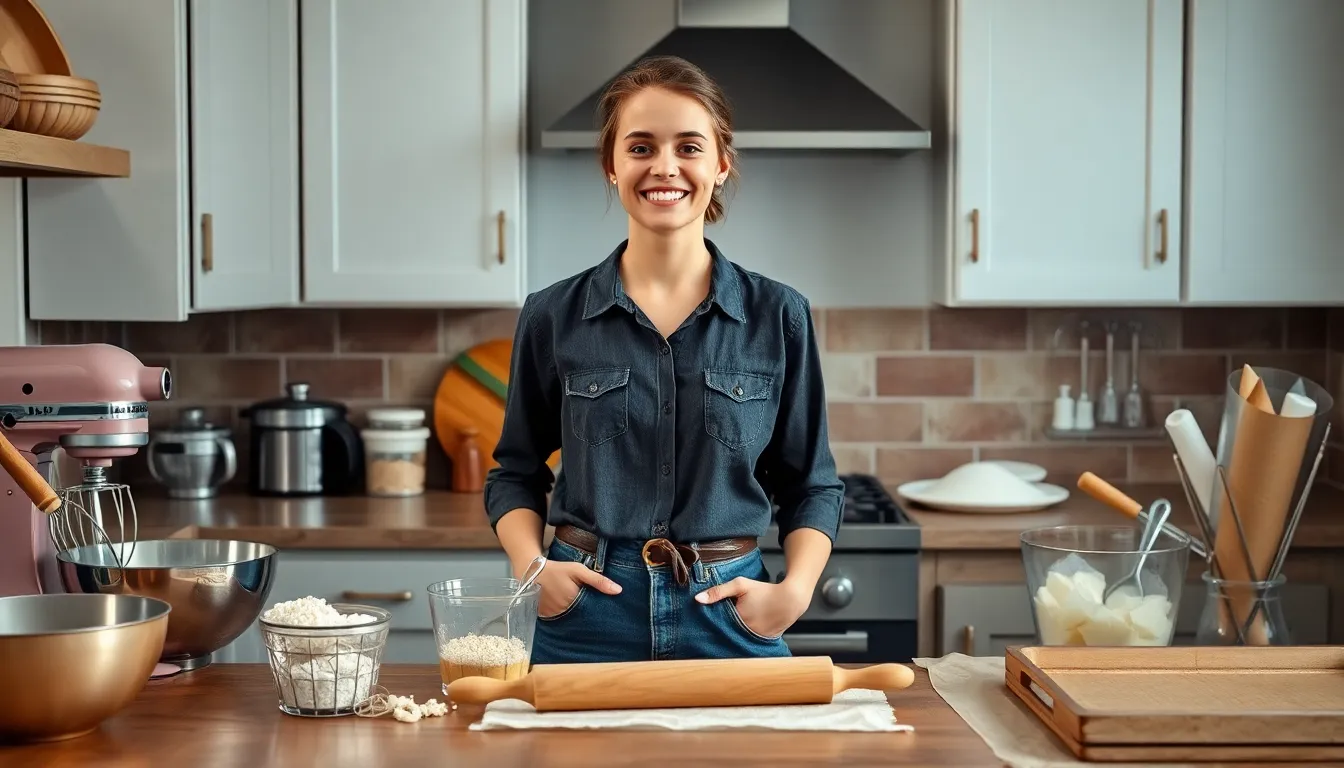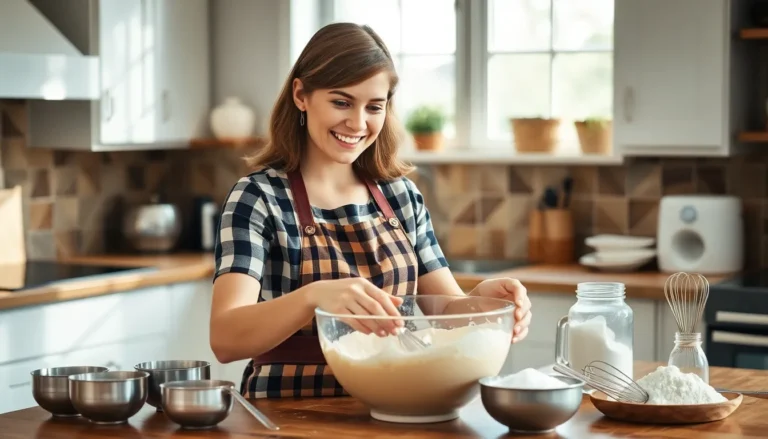Table of Contents
ToggleBaking isn’t just a science; it’s an art form that transforms simple ingredients into mouthwatering masterpieces. Whether it’s the warm scent of freshly baked bread wafting through the kitchen or the irresistible allure of cookies just out of the oven, baking has a magical way of bringing people together. Who wouldn’t want to impress their friends with a homemade cake that looks like it came straight from a bakery?
What Is Baking?
Baking combines science and art, transforming basic ingredients into delightful creations. This culinary process engages all senses, especially through enticing aromas that invite people together.
The Science Behind Baking
Chemical reactions occur when ingredients interact during baking. Yeast ferments, producing carbon dioxide that causes dough to rise. Temperature control affects texture; baking at high temperatures creates a crisp crust, while lower temperatures yield a tender crumb. Measurements also play a crucial role; precise amounts ensure balanced results. Understanding these principles helps bakers craft sweet breads, cakes, and pastries consistently.
Different Types of Baking
Baking encompasses various methods, each yielding unique results. Bread baking involves yeast fermentation, resulting in airy loaves. Pastry baking focuses on flaky textures, seen in croissants and pies. Cake baking highlights the lightness and sweetness desired in desserts. Cookies, often quick to prepare, allow for endless flavor combinations. Exploring these types opens opportunities for creativity in the kitchen.
Essential Baking Tools

Understanding essential tools simplifies the baking process. Having the right equipment ensures successful results and enhances the overall baking experience.
Must-Have Equipment
Bakers need a few basic tools to get started. Mixing bowls come in various sizes, allowing for easy ingredient preparation. A whisk aids in combining dry and wet ingredients seamlessly. Measuring cups and spoons ensure precision in ingredient quantities. A rolling pin helps flatten dough consistently. Lastly, a sturdy baking sheet accommodates cookies, pastries, and bread.
Common Baking Ingredients
Common ingredients form the backbone of many recipes. Flour acts as the primary structure for most baked goods. Sugar sweetens while also impacting texture and browning. Yeast provides leavening for bread, creating a light and airy texture. Eggs add moisture and structure, while also contributing to richness. Baking powder and baking soda serve as leavening agents, helping baked goods rise properly.
Basic Baking Techniques
Baking success hinges on mastering key techniques. Understanding these fundamentals enhances the baking experience and ensures consistent results.
Measuring Ingredients
Accurate ingredient measurement remains vital for baking. Different recipes require specific quantities to achieve the desired outcome. Dry ingredients, such as flour and sugar, benefit from precise weighing using kitchen scales. Liquid ingredients, like milk and water, should measure accurately in liquid measuring cups. Adopting the spoon-and-level technique for flour prevents overpacking and results in the right texture. Understanding the difference between weight and volume measurements also proves crucial, as it affects the consistency of baked goods. Using measuring spoons for small quantities guarantees precision in flavoring and leavening agents.
Mixing and Folding
Mixing techniques influence the final product significantly. Creaming butter and sugar together incorporates air, making cakes light and fluffy. Stirring liquid ingredients integrates flavors while avoiding overmixing, which can create dense baked goods. Folding, on the other hand, is essential for delicate mixtures like meringue or whipped cream. This gentle technique blends without deflating air, retaining lightness. Understanding how to mix and fold different ingredients ensures the correct texture, resulting in delightful treats. Achieving the right balance in mixing and folding opens up endless possibilities in baking.
Simple Recipes for Beginners
Baking becomes accessible with simple recipes that encourage experimentation. Beginners can start with quick breads and easy desserts to build confidence.
Quick Bread Recipes
Quick breads require no yeast or lengthy rising times, making them perfect for novices. Banana bread stands out as a popular choice, combining ripe bananas, flour, sugar, baking soda, and eggs. Muffins also offer versatility, allowing various flavors like blueberry or chocolate chip. Another option is cornbread, which pairs well with savory dishes and only needs cornmeal, flour, milk, and eggs. These recipes encourage creativity while producing delicious results.
Easy Dessert Options
Desserts bring joy, and simple recipes make it achievable to create sweet treats. No-bake cheesecake is a great starter, needing cream cheese, sugar, and a graham cracker crust. Brownies present another easy choice, requiring flour, cocoa powder, and sugar for fudgy perfection. Cookies, like chocolate chip or oatmeal raisin, deliver satisfying variations, needing just basic ingredients like flour and butter. Each of these options fosters enjoyment and enjoyment in baking, allowing beginners to explore flavors and textures.
Common Baking Mistakes to Avoid
Baking involves precision, and several errors can lead to disappointing results. Recognizing these common mistakes can significantly improve outcomes.
Overmixing Batter
Overmixing batter often creates tough, dense baked goods. Mixing incorporates air, which helps leavening; however, too much mixing activates gluten in flour. The result is a chewy instead of tender texture. Aim to mix just until combined. Visual cues, like a few lumps remaining, indicate the batter is ready. This approach works well for muffins and quick breads, where a delicate crumb is desired. Shorter mixing times yield lighter, airier results that maximize flavors.
Incorrect Oven Temperature
Incorrect oven temperature affects the baking process dramatically. If the temperature is too high, baked items may brown too quickly on the outside while remaining raw inside. Conversely, a low temperature can lead to excessive spreading or insufficient rise. Use an oven thermometer to verify accuracy, ensuring consistent results. Preheating ovens for at least 15 minutes prepares the environment for proper baking. The importance of temperature control in achieving the desired texture and flavor cannot be overstated.
Baking opens up a world of creativity and connection. It’s a delightful journey that transforms simple ingredients into mouthwatering treats. With the right tools and techniques anyone can embark on this flavorful adventure.
Embracing the science and art of baking not only enhances skills but also brings joy to those who share the results. As novice bakers gain confidence through practice and experimentation they’ll discover the satisfaction of creating delicious memories.
Whether it’s the aroma of freshly baked bread or the sweetness of cookies shared with loved ones baking fosters a sense of community and accomplishment. So grab those mixing bowls and start exploring the endless possibilities that await in the kitchen.



